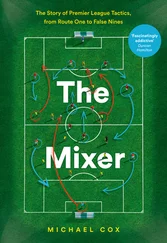There’s one final, forgotten Barcelona goalkeeper from this period who deserves belated recognition: Jesús Angoy. Another sweeper-keeper from Barcelona’s academy, he played just nine La Liga games between 1991 and 1996, largely without distinction, serving as back-up to Zubizarreta and then Busquets. But for two non-footballing reasons he is significant: first, he was married to Cruyff’s daughter Chantal, suggesting that the Cruyffian affection for footballing goalkeepers was somehow genetic. When Chantal gave birth, the beaming new grandfather Johan told the media that the newborn ‘has got big feet and big hands – the feet are for playing football and the hands are for picking up his wages’, with not even a passing thought that the hands might be useful for following his father into goalkeeping. Second, Angoy departed Barca in 1996 at the same time as Cruyff, but stayed in the city to continue his playing days over at the Olympic Stadium. Busquets didn’t move to Barca’s city rivals Espanyol, however; he switched sports and signed for NFL Europe side Barcelona Dragons. You might think this would be a natural transition for a goalkeeper, as American football is all about catching and throwing, but Angoy was actually the Dragons’ placekicker – and a very good one. He ended his second career as the second-highest points scorer in the history of NFL Europe, and turned down a transfer to the Denver Broncos because he wanted to remain in Barcelona with Chantal. Even in a sport that overwhelmingly involves using your hands, the former Barca goalkeeper specialised in the role that involves using your feet. His father-in-law presumably approved.
Playing out from the back was not, of course, solely about goalkeepers being comfortable in possession, and Dutch football placed great emphasis on defenders who offered, in Van Gaal’s words, ‘more than just defensive skills’. English football supporters were stunned when former Ballon d’Or winner Ruud Gullit, a world-class attacking midfielder, signed for Glenn Hoddle’s Chelsea in 1995 and promptly declared his intention to play as a sweeper, the position he’d played in his teenage years. ‘As a central defender I could move into midfield and would dash from there into an attacking position,’ he said. But the experiment lasted only a couple of months at Chelsea, because Gullit’s teammates simply weren’t on the same wavelength. ‘I would take a difficult ball, control it, make space and play a good ball in front of the right-back,’ Gullit recalled. ‘Except, he didn’t want that pass. Eventually, Glenn said to me, “Ruud, it would be better if you do these things in midfield.”’ The Dutch were well ahead of the game.
This had been a crucial feature of Total Football in the 1970s: defenders bursting forward when opportunities arose, with midfielders and attackers providing cover by dropping back. To make this worthwhile, however, the Ajax and Holland sides of the 1970s required defenders to be genuinely good footballers, capable of using their freedom to provide decisive contributions in the final third. Because of the importance of pressing, meanwhile, they also needed to offer speed, to play in a high defensive line and cover the space in behind.
When the Dutch adopted this policy during the 1970s it was genuinely revolutionary. Their defensive leader was Ajax’s Ruud Krol, a gloriously complete footballer who possessed the three qualities Dutch defenders would come to be renowned for – intelligence, speed and ball-playing ability. He read the game beautifully, swept up behind his fellow defenders and knocked long, diagonal balls to the wingers, sometimes doing all three in the same move. He was the only defender aside from the legendary Bobby Moore and Franz Beckenbauer to be voted into the top three of the Ballon d’Or in the 1970s, such was his impact on club and country, and he also provided the most concise summary of the Dutch approach to defending. ‘We looked to keep our opponent on the halfway line,’ he said. ‘Our standpoint was that we were not protecting our own goal – we were attacking the halfway line.’
Krol played left-back during Holland’s run to the 1974 World Cup Final, and his three defensive colleagues were also particularly attack-minded. Right-back Wim Suurbier, also of Ajax, was renowned more for his speed and stamina than his defensive ability, and constantly charged up the wing. In the middle, Holland converted Feyenoord’s Wim Rijsbergen from a right-back into a centre-back, and most significantly redeployed Ajax’s Arie Haan, a reliable midfielder, as the side’s fourth defender, although he had never previously played in defence. It’s also telling that the only two significant foreigners who turned out for Ajax during this period, Yugoslavian Velibor Vasović and German Horst Blankenburg, both played the physical, old-school hardman role, because Ajax simply didn’t produce that kind of defender themselves. ‘The foreign players brought something different,’ Cruyff acknowledged of the 1970s Ajax side. That kind of statement in England or Italy would be about foreigners bringing flair, but in the Netherlands it was about foreigners bringing fight.
By the time Cruyff’s and Van Gaal’s sides were dominating Europe in the 1990s, both were determined to promote the concept of the ball-playing defender, helped by the back-pass reform. Cruyff continued to talk about the importance of attacking the halfway line rather than defending the goal even after his retirement, complaining about ‘defenders running back towards their own goal when they lose the ball, rather than moving forward to put pressure on the players in possession’. His Barcelona side, more than any other team of the 1990s, attempted to play in the opposition half.
Such was the emphasis on ball-playing defenders, Van Gaal referred to them using a word previously reserved for attacking midfielders. ‘In modern soccer the players in the middle of the back four – the numbers 3 and 4 – have really become the playmakers,’ he said. ‘That’s why Danny Blind and Frank Rijkaard were so important to Ajax. The number 10 certainly can’t be called a playmaker because the space in which he operates is too restricted … today’s playmakers are to be found in the centre of the back four. This means, of course, you can no longer deploy the old-fashioned, solid type of player in these positions. You have to use technically and tactically gifted players like Blind and Rijkaard.’ Blind, Ajax’s captain, had played alongside Van Gaal for seven years at Sparta Rotterdam and was a calm, technically gifted footballer. But his defensive partner Rijkaard was the real star, hailed by Cruyff in his autobiography as ‘one of the best all-round footballers I’ve ever seen – he could defend with the best of them, he organised the midfield and he still had scoring potential. All of that in one person, who also had the right mentality and a good set of brains.’
Rijkaard was a curious, reserved figure constantly suffering some form of identity crisis. He was considered a thug by many for his quite literal 1990 World Cup spat with Rudi Völler, but was actually among the most amiable footballers around. He appeared a natural leader, but when Ajax manager Cruyff wanted him to become more involved in off-field duties, Rijkaard stormed out and refused to play under him again. He became a celebrity by virtue of his footballing ability, yet he found fame suffocating. He later became a successful coach, winning the Champions League with Barcelona in 2006, but walked away from management at 50, saying, ‘I don’t see myself as an authentic coach. I’ve done something for about 16 years which isn’t a match for me.’ But, most crucially in this context, Rijkaard was an outstanding defender who didn’t just want to defend.
This was nothing new for Dutch defenders, of course, but Rijkaard’s case was particularly extreme. He emerged from Ajax’s academy and became an outstanding, forward-thinking defender, partnering Ronald Koeman at Euro 88 and finishing third in that year’s Ballon d’Or voting. While Dutchmen were accustomed to Rijkaard’s attacking quality, other managers appeared surprised. ‘This is the best central defender I’ve seen in the last few years,’ raved Argentina manager Carlos Bilardo. ‘He wins everything in the air, he marks perfectly, reads the game well, has a great long pass and a great shot. He is the perfect defender, born for today’s game.’ Ireland boss Jack Charlton repeated the praise. ‘He can do everything! In England he would be worth gold. We hardly have any like him, a player who can defend and attack brilliantly.’
Читать дальше












